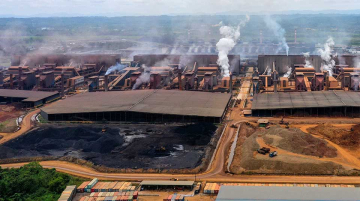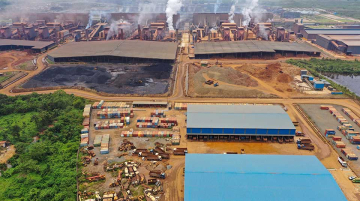
Indonesia is often cited as a model for countries seeking to extract more value from their mineral wealth. This is because Jakarta was a pioneer in using export bans to compel investors to invest in the value-added processing of the resource before export. In 2020, Indonesia banned the export of raw nickel and required companies to invest in domestic refining and smelting. The policy succeeded in attracting foreign capital, particularly from China, but with mixed outcomes.
Chinese firms dominate the processing and refining stages, retaining control over both technology and market access. Despite Indonesia’s efforts to localize more of the value chain, China remains in the driver’s seat. However, Beijing just recently imposed a 20% anti-dumping tariff on Indonesian stainless steel, citing market distortion.
Zimbabwe was the first African country to ban raw lithium exports in 2022, inspired in part by Indonesia’s model. Zimbabwe has seen a growth of Chinese investments in lithium mining and processing. However, the Indonesian case highlights the risks of relying too heavily on Chinese capital and markets. So what lessons are there for Zimbabwe?
To unpack this, I spoke with Putra Adhiguna, managing director at the Jakarta-based consultancy Energy Shift and a leading analyst in the Indonesian critical resources sector:
OBERT BORE: Putra, I’m really interested in understanding the landscape for nickel mining and refining in Indonesia. Many African countries with critical mineral resources aim to emulate Indonesia’s efforts to move up the value chain by processing these minerals domestically and capturing more value. Can you walk us through the Indonesian experience?
PUTRA ADHIGUNA: Sure. To understand where we are today, it’s useful to start with a bit of history. Indonesia used to export large volumes of raw nickel, primarily to China. Then, starting in the early 2010s, the government began introducing policies aimed at mineral beneficiation—essentially trying to move further up the value chain. One major step was the ban on raw nickel ore exports, introduced around 2014–2015.
That ban triggered significant investment, especially from China, because Chinese companies were already the main buyers. Naturally, they were also the first to invest in smelters and processing infrastructure in Indonesia. As a result, between 2015 and today, our nickel production has increased at least seven to eight times. That’s why many countries see Indonesia as a role model—we managed to attract substantial investment into domestic processing.
It’s important to understand that Indonesia holds about 40% of the world’s nickel reserves, which gives us considerable leverage. Combine that with China—both the dominant consumer of nickel and the holder of the relevant processing technologies—and you have two pieces that fit. China still needs the nickel, and Indonesia wants to industrialize, so Chinese companies set up smelters here.
But this model doesn’t work for every country or every mineral. For example, if Indonesia only produced 10% or less of global aluminum, replicating this model for aluminum would be far harder. So the first key question for any country is: how much leverage do you actually have in terms of your resource endowment? And does your buyer have a Plan B? Because if they do, they might not need to invest in your country.
Another factor is incentives. Indonesia rolled out the red carpet—we offered tax breaks, various financial incentives, and, in some cases, looser environmental regulations. That raises the issue of cost-benefit. What exactly are we giving away, and what are we getting in return? To this day, I haven’t seen a comprehensive cost-benefit analysis. And it’s not just about formal fiscal incentives. When you allow lax environmental standards, how do you quantify that cost?
So when people look at Indonesia as a model, they should start with two things: first, assess your country’s leverage, and second, evaluate the real cost-benefit of such a policy shift.
OBERT: So, given all of this, what advice would you give to Zimbabwe and other African countries that are considering following Indonesia’s path?
PUTRA: I’d say there are several things to consider.
First, look at what your neighboring countries are doing and what the major global producers are already doing. That context matters. Second, study your key destination markets. If your critical minerals are destined for East Asia or Europe, you must prepare for the regulatory environment in those regions.
Anticipating future regulation is crucial. Even Chinese battery companies are becoming more sensitive to this. For instance, Europe has battery regulations that affect the entire supply chain. If you’re making electric vehicles, you want to ensure that all your inputs meet the required standards so you can access the European market.
But let’s be honest—it’s not going to be easy. Indonesia is a test case for this. Everyone talks about “green nickel,” but nobody wants to pay a premium for it. There’s often a mismatch between expectations and market realities.
In the end, regulation will play a major role in determining whether your products are accepted in global markets. Those who meet higher standards will have access to wider markets. So, think long term and be proactive.
OBERT: What are some of the deeper lessons you think African countries can learn from Indonesia’s experience?
PUTRA: That’s a tough question, Obert—mainly because, as I said, we haven’t seen a clear cost-benefit analysis even a decade into this.
The first lesson is: be careful about what you’re being promised, and what you promise your own people. In Indonesia, the government talked a lot about building an electric vehicle (EV) industry as part of the nickel downstreaming strategy. But 10 years later, we still don’t have a real EV industry. So if you’re telling your citizens that having lithium or nickel means you’ll have EV factories soon, you need to be realistic.
Proper planning is essential. You need to ask: what exactly are we going to get in return? Don’t promise EV factories if your investment scenario only supports 20% of that goal. People are more informed now, and they’ll hold governments accountable.
Another big lesson is about environmental and social standards. There’s a tendency to dismiss these issues, especially in mining, where people say, “It’s always been dirty, it’ll never change.” I’m more optimistic. As the world transitions to greener products, those products will increasingly come with environmental and social compliance requirements, especially in markets like Europe.
That brings me back to something I’ve mentioned before: know your target market. If you want access to Europe, start preparing for their requirements now. Don’t wait until it’s too late.
You can always take the easy route of ignoring standards and fast-track investment, but it comes with consequences. In Indonesia, there’s a new article almost every two weeks criticizing our nickel industry. Whether or not it’s productive, that criticism shapes perceptions.
So if countries like Zimbabwe are serious about following Indonesia’s path, they must enforce proper environmental standards and ensure transparency in how they manage costs, incentives, and long-term returns.
Putra Adhiguna is the Managing Director of the Jakarta-based Consultancy Energy Shift






